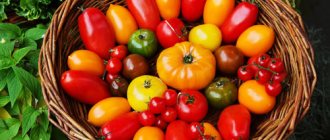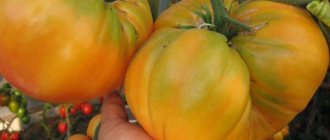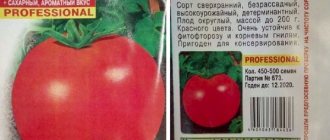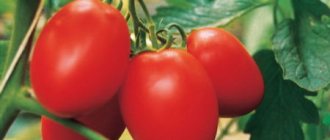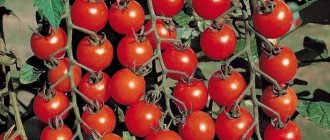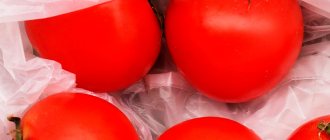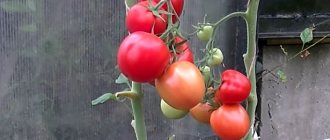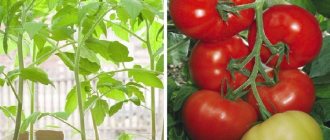Characteristic
A unique variety of tomatoes was registered in the State Register in 2007, and in a few years it spread throughout all regions from the far north to the southernmost points. Today, Southern tan is grown throughout the Russian Federation from Crimea to the Far East.
In all zones colder than temperate climates, exotic tomatoes are planted exclusively in greenhouses. In the south, the crop is cultivated in the open air and sometimes even by direct sowing in the ground.
The powerful Southern Tan bush continues to grow and lay fruit until autumn. The indeterminate type of development ensures stem heights of up to 2 meters in greenhouse conditions and greenhouses. In the open air, plants reach 1.5 meters and then stop growing.
The foliage of the bushes is average, but the characteristic drooping type of leaves requires thinning of the green part for better ventilation. The leaf blades of Southern Tan are bright green and large. Simple inflorescences are collected in loose clusters, in which 3 tomatoes are usually tied. Sometimes a bunch contains up to 8 buds, but no more than 5 of them are productive.
Flowers appear above every third leaf along the entire height of the stem. The formation of buds and fruit set stops only with the onset of cold weather. Southern tan is a mid-season variety; its first fruits ripen 120 days after the seeds hatch. In most of Russia, such crops require a seedling method of cultivation and placement in protected soil.
Varietal characteristics of Southern tan fruits:
| Coloring | At technical maturity yellow, when fully ripe bright orange with coral tan spots |
| Form | Regular cylindrical, plum-shaped, with a sharp spout at the tip of the fruit |
| Size | Large, uniform in one bunch and aligned throughout the stem |
| Weight | On average, about 150 g; with enhanced agricultural technology, individual specimens reach 350 g |
| Pulp | Oily, fleshy, seed chambers are difficult to distinguish when cut, few seeds |
| Taste | Sweet, with a small amount of acid and a pleasant aftertaste. Expert assessment – “excellent” |
| Productivity | On average, about 5 kg per bush, maximum – 8 kg. In greenhouses they remove from 1 sq. m. up to 15 kg of tomatoes, in open beds - up to 10 kg |
The delicate taste, comparable to fruit, as well as the high content of vitamins, micro- and macroelements, carotenoids, makes the tomato a valuable food product. Southern tan is included in dietary tables, menus for children and the elderly. The absence of red pigment in the pulp allows the tomato to be used in the diet of people suffering from kidney diseases, diathesis, and allergies.
The Southern Tan tomato, reviews of which fully correspond to the varietal description, produces its first harvest by the beginning of June, and then regularly supplies tasty tomatoes for more than a month. Orange tomatoes ripen in whole clusters, which is convenient when harvesting for the winter or preparing for sale.
Bright, beautiful Southern Tan tomatoes, with dense pulp, are great for whole-fruit canning, making purees, pastes, and sauces.
Tomatoes are transported at full and technical maturity over long distances. The keeping quality of Southern Tan tomatoes is excellent. In a cool room or refrigerator, the fruits retain commercial quality for up to 2 months, and at room temperature they do not spoil for about a week.
What is a Southern Tan tomato?
The tomato variety Southern Tan is a mid-season tomato variety. The description of the variety states that tomatoes can be grown both in open areas and in greenhouse conditions, including in temporary greenhouses. Growing in open beds is possible only in warm regions of the country. The growth of the bush is practically unlimited, on average the plant reaches a height of 1.7 m, sometimes it grows even more. High growth is compensated by low foliage and the absence of a large number of branches.
From 4 to 6 clusters are usually formed on one plant stem. With proper care, you can collect up to 8 kg of ripe fruits from one bush. It is recommended to plant Southern Tan using seedlings. Seeds are sown a couple of months before the intended replanting to a permanent location. The first harvest can be harvested in mid-summer, and the last at the end of August.
A description of the fruits of Southern Tan will allow those who grow tomatoes for sale to make their choice, first of all. Tomatoes have an unusual rich orange color. Red or burgundy spots can be found on the sides of ripe fruits. The shape of tomatoes resembles bell peppers or plums. On average, the weight of each fruit reaches 350 g. Under the dense and smooth skin there is dense, fleshy, sweet pulp.
The variety is excellent for baby food, as well as for consumption by those on a diet. You can eat tomatoes fresh, as slices in salads, in hot dishes or pickles, as well as as juice or tomato sauce.
Tomato is classified as a variety suitable for use in baby food or diet food. It is characterized by a high content of useful elements, including vitamins and minerals, fiber, pectin and a number of organic acids. It is useful to consume this tomato if you need to improve the functioning of the intestines and metabolic processes, and facilitate the functioning of the liver, kidneys or pancreas.
The variety has a number of advantages, among which it is worth highlighting:
- unusual and very attractive appearance of all fruits;
- non-standard orange color of ripe tomatoes;
- good taste and aroma of fresh fruits;
- the opportunity to harvest a rich harvest of fairly large tomato fruits;
- a large number of vitamins contained in each fruit.
The only drawback that makes it difficult to grow the presented variety is the need for care. Tomatoes do not tolerate unfavorable climatic conditions well, so they can produce a very modest amount of ripe fruit.
Preparation of planting material
It is more convenient to grow mid-season Southern Tan tomatoes using seedlings. Good results from sowing seeds in the ground are obtained only in the southernmost regions. The varietal qualities of the crop are completely preserved when reproduced from its own seeds.
Planting material taken from ripe Southern Tan tomatoes has a shelf life of more than 4 years. The seeds lose their viability slightly after 2 years of storage, but this deficiency can be corrected by using growth stimulants.
The time for sowing seedlings is calculated from the expected time of onset of stable heat. The usual time for Southern tanning is no earlier than early March. When growing seedlings for greenhouses, the deadline is shifted by 2–3 weeks to the second half of February.
The process of preparing and sowing seeds of the Southern Tan variety:
- Tomato seeds are disinfected by immersing them for 20–30 minutes in a pink solution of potassium permanganate. All planting containers and soil should also be disinfected. Instead of potassium permanganate, modern biological products (Baktofit, Fitosporin) have recently been used.
- At the same time, the quality of the planting material is determined: all floating seeds are rejected as non-germinating.
- Soil requirements are neutral acidity and loose structure. You can sprinkle a little sand or rotten sawdust on the garden soil. Mineral fertilizers are not added to the mixture for Southern tanning; it is enough to mix a few handfuls of wood ash per 10 kg of soil mixture.
- The dried seeds are laid out on the surface of the soil in increments of 3 cm and planted no more than 1.5 cm deep. The plantings are moistened abundantly.
- The emergence of seedlings is accelerated by a “greenhouse” device, when containers with seeds are covered with polyethylene or glass.
- At temperatures above +22 °C, seedlings appear within a week. From this point on, plants need good lighting. If there is not enough sunlight, be sure to supplement the Southern Tan seedlings with phytolamps.
Every 3 days, water the seedlings using heated water and being careful not to wet the leaves. Picking is done after two true leaves appear. Fertilizers for Southern Tan seedlings are used only in cases of extreme weakness of plants, in minimal quantities: standard complex mixtures are diluted twice as much as usual.
Southern tan has drooping foliage and may appear stunted in appearance, but this is only a varietal characteristic. Fertilizing healthy, strong plants can unnecessarily stimulate the growth of shoots, and “overgrown” seedlings lag far behind in development after planting in the ground.
Description of tomatoes
The bush is usually formed into 2 stems, they are strong and very tall. The stems are not pubescent and have many internodes. The plant does not bear a large number of stepchildren, but they still need to be removed. There are quite a lot of leaves, they are bright green. The veins are well defined, the leaf blade is embossed. Up to 10 flower clusters are formed on the stems. The inflorescences are simple, all flowers bloom at the same time. After pollination, round cylindrical fruits are formed, in the form of a large plum with a spout.
Technical ripeness is characterized by a dark orange color; sometimes the stalk has a lighter shade interspersed with green. The fruit is large, its weight can exceed 400 grams. The taste of tomatoes is sweet, without sourness. Productivity may fluctuate, but it is 2 times greater in greenhouses than in open ground.
Use
The bright, colorful dark orange fruits are suitable for all types of consumption.
- They are good fresh, as a sweet dessert snack with bread.
- Suitable for salads and decoration of dishes, as well as a dietary product.
- The juices from such fruits have a beautiful amber color and have a lot of pulp.
- Siberian Southern Zagar tomatoes are suitable for canning in their entirety.
- Pickles, ketchups and dressings for second courses look excellent.
When canning, in jars you can see a real Garden of Eden, bright plum fruits, surrounded by spicy greens. Some housewives, in addition to canning, have adapted to drying fruits. They turn out fleshy, similar in appearance to dried apricots.
It is recommended to consume fresh tomatoes to improve metabolic processes in the human body and to prevent inflammatory processes in the kidneys, liver and stomach. Used to treat burns and skin injuries. Orange fruits are irreplaceable both for anemia and partial weakness of all vital functions of the body.
Preparing the soil and planting site
The Southern Tan tomato, reviews of which confirm that the crop is undemanding to the soil, is able to grow and bear fruit on soils of very different qualities. The main requirements for the composition of the substrate are looseness, water permeability and a reaction close to neutral.
Southern Tan tolerates slight acidification of the soil well, but with strong deviations, additional addition of dolomite flour, ash or chalk is required for digging.
It is advisable to deoxidize the soil and add organic matter in the fall, and to increase fertility it is recommended to add well-rotted manure or compost in limited quantities. For Southern tomatoes, it is enough to improve the structure of heavy soil by adding sand or sawdust. Try not to use organic fertilizers (especially bird droppings) for tomatoes.
When choosing a planting site, first of all pay attention to the lighting. Southern tanning requires an abundance of sunlight. Do not plant tomatoes in beds where tomatoes, potatoes, or any nightshade plants previously grew. Preference is given to areas where onions, garlic, melons, zucchini, cucumbers or cruciferous vegetables (radish, cabbage) previously grew.
Useful properties and advantages of the variety
The Southern Tan tomato belongs to the category of dietary and baby food. It has been praised for its content of beneficial vitamins and minerals. The fruits contain fiber, pectin, and organic acids.
Eating tomatoes helps normalize metabolic processes and improve the functioning of the liver, kidneys, and pancreas. When eaten fresh, it has an anti-inflammatory effect and helps increase appetite.
The fruits of Southern Tan tomatoes are recommended for use in cases of obesity, anemia, and anemia. They have proven themselves well on the children's menu.
The popularity of the variety led not only to its undoubted benefits, but also to high ratings from gardeners.
The benefits of Southern tanning include:
- attractive appearance;
- unusual fruit color;
- excellent taste;
- high productivity;
- high content of vitamins;
- large mass of fruits.
Among the shortcomings, gardeners note that the variety is somewhat capricious in care. In case of unfavorable conditions, it produces a low yield.
Landing algorithm
High-quality Southern Tan seedlings, completely ready for removal to a permanent place, can be obtained in 50 days. Such plants have at least 6 well-developed leaves and reach 30 cm in height. If the weather is unsuitable or the seedlings are not ready, they can be grown for another 10 days.
Young bushes are first hardened by exposing them to the air for several hours every day for a week. Before transplanting, leave the plants outside for the whole day.
Sequence of work when planting Southern tan seedlings:
- The beds are marked taking into account their placement per 1 square meter. m no more than 3 plants. In the greenhouse it is convenient to care for bushes growing in a checkerboard pattern at a distance of 60 cm from each other.
- Make holes slightly larger than the dimensions of the earthen ball with roots, and also install supports for gartering tall tomatoes in advance.
- The seedlings are planted together with an earthen ball or peat pot, cut in several places around the perimeter. The stems of Southern tan can be buried in the ground a few centimeters more than they grew before.
- The plantings are watered abundantly with heated water, the soil is allowed to settle, and the missing soil is sprinkled onto the roots.
- Mulching with organic materials (sawdust, cut grass, straw) helps keep the soil loose and moist and prevents the formation of a soil crust.
Outdoors in sunny weather, it is advisable to shade the plantings for several days. Since in most of Russia Southern Tan is grown in protected ground, additional shelter from the night cold is not required.
How to plant a variety?
The Southern Tan tomato is suitable for greenhouses and open ground. The height of the bush is 30 cm. The shoots should have 6-8 leaves. Under the film, the variety produces a high-quality harvest, as it is resistant to climate change.
The best predecessors of tomato are cucumbers, pumpkin, carrots, onions, and garlic. The soil should be dug up and fertilized with compost or rotted manure. The crop cannot be planted after peppers, eggplants, potatoes and other tomatoes.
Holes are prepared especially for tomatoes. There should be no more than 3 plants on each square of land. Greenhouse tomatoes are arranged in a checkerboard pattern to make them easier to care for.
The seedlings of the crop are transferred to another place with a lump of earth. The roots are sprinkled with soil and its surface is leveled. The bushes need to be watered with warm water.
Care
Tomato Southern tan reviews from summer residents are classified as unpretentious crops. Even novice gardeners can grow healthy, strong tomato bushes. But the yield of orange tomato directly depends on care.
The most important procedures for this are the formation of sparse bushes and regular watering. Southern Tan is also sensitive to fertilizing, which has its own characteristics for this variety.
Spraying, watering
For the first time after planting, Southern Tan is watered after 10 days. During this time, the roots have time to adapt and begin to actively consume moisture. Mulching helps keep the soil moist during this time, and the survival rate of seedlings increases significantly.
The heat-loving variety Yuzhny prefers constant humidity. Watering is required at least once every 3 days, while ensuring that the soil is moderately saturated.
When water stagnates, the one-time fluid intake is reduced. For this variety, drip irrigation is especially appropriate, delivering water directly to the roots and maintaining constant moisture without waterlogging.
Top dressing
Tomatoes of the Southern Tan variety do not require abundant organic fertilizing. On infertile soils, it is recommended to apply such fertilizers once a season during digging. The variety is very sensitive to mineral compounds and responds to proper feeding by increasing the ovary and filling with tasty fruits.
Rules for applying fertilizers for the Southern Tan tomato:
- Tomatoes of this variety require at least 3 feedings during the growing season.
- The first application of fertilizers is carried out no earlier than 15 days from the time of planting the seedlings. Plants must be completely acclimatized and begin to grow.
- All mineral mixtures for fertilizing must contain potassium and phosphorus compounds. Nitrogen fertilizers for Southern tanning are completely excluded.
- Wood ash and dolomite flour are recommended organic fertilizers; they are applied both to the beds for digging and during the growing season. Ash is useful to use in dry powder (for pollinating bushes) or in the form of watering solutions.
- Foliar feeding to which Southern Tan responds well is a weak solution of potassium permanganate and boric acid with the addition of a few drops of iodine.
Young tan bushes respond well to treating the bushes with biological preparations, which simultaneously increase immunity to diseases and stimulate additional nutrition. Experienced vegetable growers recommend spraying and watering with the addition of Baikal, Sufler, and complex mineral fertilizers for tomatoes called Kemira Lux.
Trimming, tying, pinching
Reviews call the Southern Tan tomato not the tallest giant in greenhouses. Sometimes the crop grows on its own, otherwise the growth point of the stem is pinched at a height convenient for the gardener himself. In open ground, the crop is formed into one stem; for greenhouses, 2 strong stems are left.
Rules for forming a Southern tan bush:
- all side shoots (stepchildren) must be removed, and the foliage is regularly thinned out;
- Below the first flower cluster, the leaves are removed immediately after the ovary appears on it;
- As the tomato stems grow, they are tied to a high support; support is also required for the largest bunches of tomatoes;
- Above the ripening tomatoes, remove the foliage that obscures the sun's rays.
Thinning and pinching of Southern Tan bushes is carried out every week. Regular removal of leaves helps improve the ventilation of plants, which reduces the risk of “tomato” diseases, and also speeds up the fruiting.
Temperature and humidity
The heat-loving and moisture-demanding variety Southern Tan is similar in these characteristics to a tropical plant. In open ground, cultivation is rarely possible even in the temperate climate of the middle zone. The variety is ideal for greenhouses or film shelters, as it does not shed flowers and ovaries when overheated, and also tolerates high air humidity quite steadfastly.
In open ground, among the problems with returning colds, Southern Tan tomatoes also experience slow growth and delayed fruiting due to daily temperature fluctuations. Seedlings can freeze in development even in relatively warm weather – from +15 °C.
The degree of illumination is very important for the growth and formation of the crop. Even at the seedling stage, Southern Tan requires 12 hours of daylight. Plants on the windowsill have to be illuminated with lamps in the morning and evening. After planting in a greenhouse, the best results are obtained by bushes that receive maximum sunlight, as well as artificial lighting when necessary.
Requirements for seedlings
For tomatoes to germinate, a temperature of +25 is required.
Tomato sprouts form in 5-8 days. Containers must be in a lighted place. Culture can develop only under suitable conditions:
- daytime temperature 20-25 degrees;
- night – 12-18 degrees;
- fresh air;
- calm;
- timely supply of water;
- 12 hour daylight hours
Tomato seedlings are watered from a sprayer with water at room temperature. If the sprouts have 5 leaves, they need to be supplied with water every week, and then once every 3-4 days.
Seedlings with strong stems and green foliage do not require fertilizer. Suppressed tomatoes are supported with complex compounds. In 1 l. add a teaspoon of Agricola or Cornerost to water. The vegetable needs to be watered at the root.
Possible diseases and pests, ways to get rid of them
The Southern Tan tomato, judging by reviews from amateur vegetable growers and farmers, does not have absolute immunity to typical “tomato” diseases. But usually the bushes are the last to become sick in the presence of diseased tomatoes of other varieties or when agricultural practices are not followed.
The timing of the fruiting of Southern Tan does not make it possible to harvest the entire crop before an outbreak of fungal infections, so the variety should receive all preventive treatments on the same basis as other tomatoes. Spraying Bordeaux mixture (3%), Baktofit, Fitosporin every 15 days helps protect plants from fungal and bacterial infections.
A typical disease for Southern tan in any climate is Alternaria blight (bloom rot). This disease is not associated with any type of infection, but develops due to a lack of minerals. A lack of calcium, manganese and phosphorus leads to disease in green tomatoes. An additional risk factor is acidic soil and excess watering.
Alternaria tomato blight Southern tan
Alternaria blight manifests itself as damage to the tips of fruits, which soften and turn brown. Over time, the disease spreads to the entire unripe crop. You can prevent the disease of Southern Tan tomatoes even at the stage of laying the beds: adding dolomite flour and ash charges the soil with the necessary minerals.
If, however, the disease is noticed on some fruits, they should be removed and then the bushes should be treated with calcium nitrate. After 3 days, spraying is carried out with a complex fertilizer such as Kemira. With the next watering of the Southern Tan, mineral fertilizing is also applied to the soil or superphosphate and potassium chloride are added to the water for irrigation.
Regular fertilizing not only nourishes the bush, but also repels pests. Ticks and slugs cannot tolerate the presence of dolomite flour. Aphids, spider mites, and whiteflies do not disturb Southern Tan in greenhouses when treated with the biological insectoacaricide Fitoverm. The bushes are sprayed with the drug three times with a break of 5 days.
If the Southern Tan bush is heavily damaged by pests in the open ground, it is abundantly irrigated with Fitoverm, wrapped in polyethylene and left for several hours. In open beds, you can use stronger chemicals: Actellik, Aktara or Fufanon.
What causes Southern tanning?
Of all the diverse diseases, the Southern Tan variety is usually affected only by blossom end rot. This disease is non-infectious and develops due to a lack of nutrients (calcium, manganese, phosphorus, boron) and improper watering.
Blossom rot affects Southern Tan tomatoes due to a lack of microelements
Prevention of the disease is treatment with mineral fertilizers.
Among the pests, especially in a greenhouse, Southern Tan can be affected by aphids, whiteflies and spider mites. Tomatoes can be saved from them using treatments with Fitoverm, Actellik or Aktara.
Peculiarities
A bright, productive variety of tomatoes very quickly won the recognition of vegetable growers throughout Russia. Based on reviews from large farms and summer residents, one can determine the advantages of Southern Tan, which force them to plant it year after year both in open ground and in film greenhouses or heated greenhouses.
Positive qualities of the variety:
- excellent taste and high accumulation of sugars even in regions with cool summers;
- unusual color and absence of carotenoids, which irritate the kidneys and also cause allergies to tomatoes;
- nutritional value, high concentration of vitamins;
- large fruits aligned in one cluster, ripening simultaneously;
- good transportability.
Among the disadvantages, vegetable growers note the presence of lean seasons associated with weather conditions. But even a small amount of Southern Tan fruits pays for the space occupied in the greenhouse due to the always excellent taste and attractive appearance of the tomatoes.
Some disadvantages of the variety noted in practice:
- the need for increased fertilizing during the growing season;
- soreness of the bushes during prolonged rains with a drop in temperature;
- drooping foliage, giving the impression of stunted plants;
- the need to select fertilizers due to the inability to introduce organic matter rich in nitrogen.
The Southern Tan tomato does not cause any difficulties in growing for most amateurs and professional vegetable growers. Reviews from those who failed to get a decent harvest the first time say that the taste and appearance of the fruit forces gardeners to reconsider agricultural practices, change their approach to fertilizers and plant the treasured variety again.
Southern tan captivates gardeners not only with its exotic appearance, but also with the high quality of sweet fruits, which is not always achievable with other varieties in the northern regions.
Advantages and disadvantages of the variety
“Southern Tan” tomatoes have been familiar to farmers for more than 10 years; during this period they have earned popularity due to their many advantages:
- Large size and excellent taste of the fruit.
- High yield under film cover and in greenhouses.
- Useful properties and dietary characteristics of fruits.
- Universal use of tomatoes.
- Plant resistance to most diseases and pests.
How to plant and grow an apple tree from a seed at home?
Flaws:
- Under negative weather conditions (high humidity, low or high temperatures), yields sharply decrease.
- Low humidity leads to the formation of blossom end rot.
Transplantation to a permanent place
Young seedlings are moved to a permanent place 55-60 days after sowing the seeds. By this point, with proper care, the seedlings reach a height of 25-30 cm and have 5-7 true leaves.
The soil should be loose and moderately nutritious. An excessive amount of organic and mineral substances in it will contribute to too active growth of green mass without forming ovaries.
It is not recommended to plant tomatoes after nightshade crops, which have similar diseases to tomatoes, which can leave behind contaminated plant debris and soil.
Suitable precursors include onions, garlic, members of the pumpkin family, and herbs.
Planting scheme: 2-3 bushes per m². Too thick growth will not only make maintenance difficult, but will also significantly reduce crop yield.

